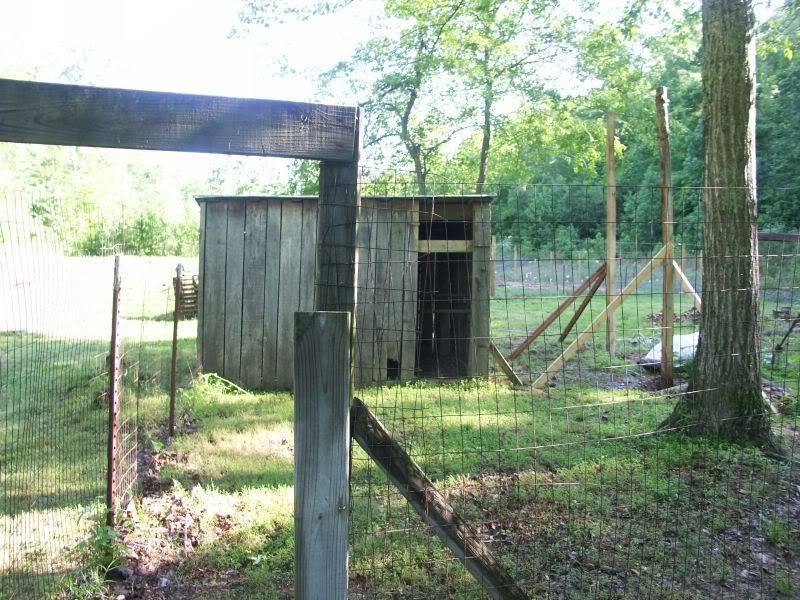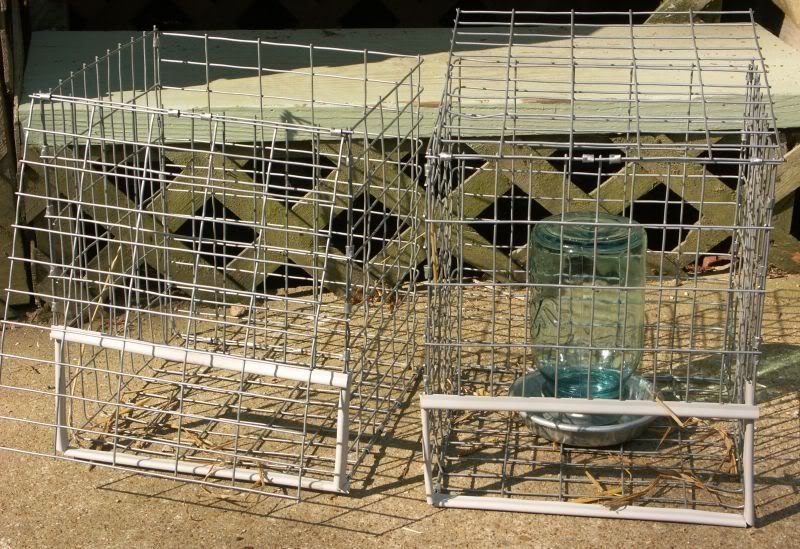Our new place had an old, run down chicken house and two adjoining pens: one with a fenced in roof, one open to the sky. In 2006 we rebuilt the chicken house and got our first guineas that May; month old keets – nine of them. Things went well with this experiment, so a month later we added 16 chicks – day old buff orpingtons. By then the guineas had acclimated to the new digs and were exploring the property. That December the orpingtons were laying eggs. At the end of the month we had received 25 eggs; by the end of January 2007 the total was over 200. We lost one hen to prolapse and slaughtered six excess roosters for meat, but all other birds are still here. In May of 2007 we started turkeys and fired up an incubator to start hatching some of the eggs collected from the guineas and chickens.

old chicken house

new chicken house
We are fortunate in that we don’t have problems with predators. There are coyotes out there, I can hear them singing in the evenings. There are fox, possum, raccoon, owl, hawk and other predators. My guess is the dogs keep the land based predators at a distance, and the flying predators are loathe to tackle anything too big to fly off with. Chicks and young birds are kept secure. Still, someday the word may get out, and with all the clear-cutting in the region, wildlife is being herded into our land. Traps and shotguns are the only option, and may become a necessary part of management someday.
So far as diseases are concerned we do our best to keep new additions isolated and on medicated feed for at least two weeks, until we are sure they have acclimated to the disease pool our flock has. The medicated feed contains an antibiotic, which will do nothing to a virus, but helps to keep bacterial problems down while the poultry develops its immune system. It is a nuisance, having medicated feed around laying hens. I have talked to many people that will eat the eggs of a hen eating medicated feed, but I prefer not to. That means going to some trouble to keep the larger birds out of the medicated feed. Other than complete isolation, the only other solution I have been able to come up with is small cages to hold feeders. The entrance is too small to admit an adult bird. So far we have been lucky. You can’t keep wild birds away from the poultry – they are small enough to fly through chicken wire and glean missed pieces of scratch. Rodents are another problem. I prefer the large live traps that can fill up with mice before emptying. Mouse droppings in the yard are a fact of life, and so far the best way to meet these potential infection risks is keeping the birds healthy and letting their immune systems acclimate. It also makes mouse and rat proof containers for feed an absolute necessity. Rodents will get large enough feeding off of gleanings; if they get access to the chicken feed you will raise a large population of healthy rodents, attracting snakes and other predators.
If the existing pens were not already in place, I don’t know that we would have been so ambitious in our construction. The covered pen is made from landscape timbers with chicken wire. Much smaller quarters would have served, simpler in construction, and I have no doubt that is the direction we would have gone. If I had it to do over again, a smaller house above ground would have been better. The chickens need room to roost, lay eggs, with space for a feeder and waterer being a convenience. Room to run a rake under the housing would be a major improvement over the current arrangement. Even better would be a height that would allow a wheel barrow or small trailer to be backed under the edge of the house so that litter could be raked directly into it. With the poultry roaming at large during most of the day, housing is more of a security matter and allows accounting for the flock every night. My neighbor has an excellent arrangement. His feeders are the “J” type rabbit feeder. They are attached to the wall on a hinged door that allows him to reload the feeder from the outside of the chicken house. Eggs are removed in a similar manner, through a trap door that opens into the back of nesting boxes. His pen was made from hog panels covered with chicken wire and stretches over a creek, allowing fresh water for his chickens year round.
This last summer two guineas have successfully hatched their broods and our incubator hatch finished with almost 100% success. One of the keets hatched in the incubator was badly splay-legged. We gave it a few days to improve, but the condition did not improve and it was culled. We now have a surplus of guineas that will be used to buy goodwill from a neighbor that has come through for us in the past. All chicks were brooded for about two weeks, and then moved outside. By the time the turkey poults were a month and a half old, they were too big to keep with the keets and chicks any longer. The poults were moved in to house with the adult chickens (with their little bantam buddy). After moving the poults we found three keets that appeared to have been smothered in a pile-up. If we had moved the poults a few hours earlier, those keets would have survived. Most of the orpington chicks are headed for the freezer. I am still impressed with the hardiness of the breed. Where keets are small and flighty, the orpingtons are large and calm.

homemade brooder box

creep feeder for chicks
To raise poultry from egg to freezer and all points in between, it is handy to have a few sizes of feeders and waterers. Mason jar type feeders and waterers are handy for brooding age. A slightly larger trough type feeder for older chicks works well for us. If the area where these feeders are located is exposed to the weather, it will be necessary to make a small shelter to keep rain out of the feed. I’ve cobbled together a few of these from scrap lumber. Adults eat from larger hanging feeders. Hanging feeders and waterers are an excellent way to keep bedding litter and mice out of the food and water. We have had a lot of luck with an outfit named Double-R Supply for competitive prices and quick service on these larger feeders. Most useful are the feeders with small partitions in the feed tray – it reduces waste from the bird’s natural tendency to root and rummage through feed.
Surplus eggs and meat are good for barter. We currently produce more eggs than we can use, and they have purchased much goodwill, brought in enough income to pay for feed, and been traded for help with projects that needed more manpower than we could provide. Once the freezer is stocked I hope to trade for pork, beef, cheese and other products we don’t produce. To make a business of poultry, one that could provide a livelihood, it would take a greater commitment and ruthless efficiency. We like to keep it casual. Casual doesn’t mean complete negligence. There are times during the winter where I have to get out in the morning with a bucket of hot tap water to fill dog dishes in the pens because the waterers have frozen during the night. Some weeks it’s every morning. They need to be fed and watched over, but if it’s done right the effort can be kept to a minimum and the benefits almost effortless. Meat, eggs, bug control and manure for the compost bin.
The taste of meat and eggs from free ranging poultry is significantly better than anything you can purchase at a store or restaurant. On a less practical side, poultry is good for the soul. There is nothing more relaxing than watching the hens scratch in the yard and listening to their clucks and cackles – almost muttering under their breath. It is a soothing sound and leaves you feeling that everything is going to be all right. If you have the space, consider experimenting with poultry.
Regards,
Pat
